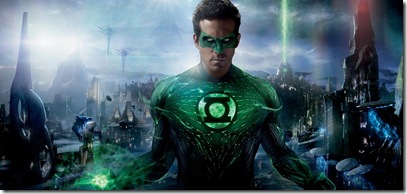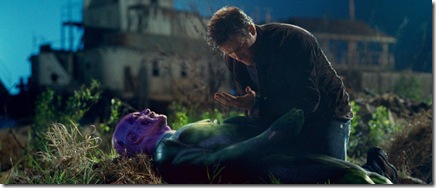Martin Campbell’s Green Lantern hits the key moments of the character’s origin, mixes in a couple of classic villains, the right girlfriend and sets up at least two potential sequels – but fails as the promised ‘cosmic adventure.’
Green Lantern has one of the densest mythologies in the DC pantheon of heroes and, as a result, the movie version has to rely on an awkward, portentous prologue to give the movie audience the information it needs to get into the story. Once that’s done, we are introduced to the characters and follow along as cocky test pilot Hal Jordan [Ryan Reynolds] is chosen to become the first human member of the 3,600-member Green Lantern Corps that acts as a police force to the universe.
Sounds pretty cosmic, right? Well, there are a few cosmic moments, but most of the film is set on Earth – beginning with the crash of Abin Sur’s [Temuera Morrison] spacecraft and his ring choosing Jordan to replace the dying GL. This comes on the heels of Jordan and Carol Ferris [Blake Lively] taking part in a test of unmanned jets in dogfight to win Ferris Aircraft a government contract – a test that goes awry, nearly killing Jordan while giving us a flashback to Hal watching his father die in another test flight when he was a boy.
Thanks to the prologue, we know that an evil entity composed of the yellow energy that is generated by fear – called Parallax [voiced by Clancy Brown] – is responsible for Abin Sur’s death and plans to destroy the Guardians, the creators of the Green Lantern Corps. It gets sidetracked when xenobiologist Hector Hammond [Peter Sarsgaard] is infected by a remnant of yellow energy when he performs the autopsy of the fallen GL for the U.S. government. In parallel arcs, we watch as Jordan and Hammond evolve in different directions once they’ve had their life-altering experiences.
Outside of a day spent training on the Green Lantern Corps’ home planet, Oa – and an attempt by Jordan to enlist the aid of the Corps to prevent Parallax from destroying Oa [a total of less than fifteen minutes] – Jordan is on Earth for the most part. The most important thing we learn to this point in the film is that the rings that give the Corps its power are generated by the green energy of will power.
The key moments of GL’s origin [Abin Sur, Hal being chosen by the ring, the Green Lantern Corps] have been the same since Julius Schwartz and John Broome introduced the Hal Jordan version in 1959. The most recent version, written by Geoff Johns [an executive producer on the film], is the one used here.
Between the Jordan and Hammond arcs, there are a few moments for the greatest Green Lantern, Sinestro [Mark Strong], but they are mostly speechifying. His one significant action scene has him beating the snot out of Jordan – putting him in position to eat significant crow later.
I could go into the details of the plot, but, frankly, it’s more than convoluted and – since there’s not much there in the way of the promised cosmic adventure – I’ll simply move on to the bigger picture.
Reynolds keeps Green lantern from being a dismal failure. The cast is pretty strong, overall – Lively is surprisingly strong playing the significantly older Carol Ferris; Strong has great presence as Sinestro; Sarsgaard almost overcomes the weak writing for Hammond – and there are lots of details for comics fans [Angela Bassett as Amanda Waller, anyone?]. The problem is that Green Lantern, the movie, plays out as a series of episodes rather than a unified whole – possibly because of the [credited] four person writing team – and the direction does not feel like a singular vision. The cosmic stuff and the Earth-based stuff are two different movies – one pompous and heavy-handed; the other more relatable but unfocused.
The effects are generally, well, effective and occasionally spectacular – but not necessarily at the same time. The 3D is good – no fuzzy bits during action sequences, but unless you’re seeing the film in one of those spiffy new cinemas that have state of the art sound [they’re called AVX – for Audio-Visual Experience here in the Great White North], it’s not really enough to warrant shelling out three-to-five extra bucks.
As for Parallax, it’s really hard to take a monster seriously when it looks like a moving cloud of diarrhea – which is to say, this is one of the worst designs I’ve ever seen for a super-villain in a superhero movie. Frankly, it makes the Galactus cloud from Fantastic Four look good.
Although I understand the filmmaker’s need to include the more cosmic aspects of Green Lantern in the movie, it would have been far better if Hammond had been developed more and used as the first villain. There are hints of the relationship between Jordan and Hammond and that would have resonated much more, emotionally. Also, it would have given us a better springboard for a sequel than the unsurprising scene that interrupts the end credits.
In the end, though, the cast – and especially Reynolds – save the film from being a disaster. Reynolds’ charm [check out the throwaway line about the mask] and gift for relatable self deprecation – as well as some decent dramatic chops – turns out to have been a great choice to play Hal Jordan. It doesn’t hurt that he has the body for the green energy costume, either.
So, then, Green Lantern may not be a great movie but the character seems worthy of a [much better] sequel. One can hope.
Final Grade: C+


“Green Lantern” is the film version of the long running comic book series. Story is about a test pilot who is chosen by a magic ring when the alien who had the ring crashes to earth and dies. Mostly smoke, special effects, and strange creatures. Our superhero overcomes his fears and saves the day.
GRADE = “C”